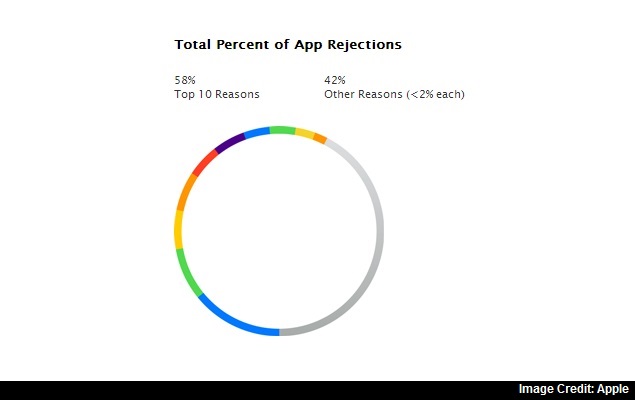Apple Reveals the Most Common Reasons for App Store Rejection

The company's developer website notes, "Before you develop your app, it's important to become familiar with the technical, content, and design criteria that we use to review all apps. We've highlighted some of the most common issues that cause apps to get rejected to help you better prepare your apps before submitting them for review."
(Also see: Apple's New App Guidelines May See Candy Crush Saga Pulled From App Store)
The developer page by Apple tries to explain how developers can avoid their app's rejection and make the cut into the App Store. According to the company, a developer should submit an app for review only when it is complete and ready to be published; apps must feature a refined and user-friendly UI that follow the guidelines issued by the company; all links in the app must be functional; all images and text should be finalised before submitting the app for review; the app must be tested on an iOS device to verify that ads work correctly; apps that serve adds should mention use of the Advertising Identifier (IDFA); the app's description and screenshots should clearly and accurately convey the app's functionality; app must perform as advertised and should not give users the impression that the app is something it is not.
Apple adds that developers should accurately and comprehensively fill-up the App Review Information section of iTunes Connect when submitting their apps, ensuring that all information, credential and hardware required by the reviewer is available. The company also said that the repeated submission of similar apps should be avoided to prevent tying up the review process - recommending users submit only one iteration at a time.
Finally, before pointing users to the App Review Guidelines and Resources section, Apple added that apps without 'enough lasting value' will be rejected. It explains, "If your app doesn't offer much functionality or content, or only applies to a small niche market, it may not be approved. Before creating your app, take a look at the apps in your category on the App Store and consider how you can provide an even better user experience."
(Also see: Apple Removes Hit Marijuana Farming Game From App Store)
As we mentioned earlier, Apple on the same page also listed the top 10 reasons for app rejections during the 7-day period ending August 28, 2014.
- 14% More information needed
- 8% Guideline 2.2: Apps that exhibit bugs will be rejected
- 6% Did not comply with terms in the Developer Program License Agreement
- 6% Guideline 10.6: Apple and our customers place a high value on simple, refined, creative, well thought through interfaces. They take more work but are worth it. Apple sets a high bar. If your user interface is complex or less than very good, it may be rejected
- 5% Guideline 3.3: Apps with names, descriptions, or screenshots not relevant to the App content and functionality will be rejected
- 5% Guideline 22.2: Apps that contain false, fraudulent or misleading representations or use names or icons similar to other Apps will be rejected
- 4% Guideline 3.4: App names in iTunes Connect and as displayed on a device should be similar, so as not to cause confusion
- 4% Guideline 3.2: Apps with placeholder text will be rejected
- 3% Guideline 3.8: Developers are responsible for assigning appropriate ratings to their Apps. Inappropriate ratings may be changed/deleted by Apple
- 2% Guideline 2.9: Apps that are "beta", "demo", "trial", or "test" versions will be rejected
Those quick at maths will figure the above percentages only add up to 58 percent. Apple explains that while 58 percent of all App Store rejections are because of the top 10 reasons, 42 percent are due to other reasons which however account for less than 2 percent each.
The reasons for Apple creating such a guide are quite clear. Thousands of developers each month struggle to understand why their apps were rejected, and this gives them and the general public a better idea of why. The company, by educating developers about the most common reasons for app rejection, is also ensuring developers make better, more compliant apps that do not tie-up Apple's review process - effectively helping both parties.
Recently, Microsoft removed more than 1,500 apps with confusing or misleading titles that violated its new Windows Store app certification requirements.
Microsoft acknowledged that people were "finding it more difficult to find the apps they were searching for, often having to sort through lists of apps with confusing or misleading titles". The revised policy was a first step that the company took towards fixing this problem.
For the latest tech news and reviews, follow Gadgets 360 on X, Facebook, WhatsApp, Threads and Google News. For the latest videos on gadgets and tech, subscribe to our YouTube channel. If you want to know everything about top influencers, follow our in-house Who'sThat360 on Instagram and YouTube.
Related Stories
- AI
- iPhone 16 Leaks
- Apple Vision Pro
- Oneplus 12
- iPhone 14
- Apple iPhone 15
- OnePlus Nord CE 3 Lite 5G
- iPhone 13
- Xiaomi 14 Pro
- Oppo Find N3
- Tecno Spark Go (2023)
- Realme V30
- Best Phones Under 25000
- Samsung Galaxy S24 Series
- Cryptocurrency
- iQoo 12
- Samsung Galaxy S24 Ultra
- Giottus
- Samsung Galaxy Z Flip 5
- Apple 'Scary Fast'
- Housefull 5
- GoPro Hero 12 Black Review
- Invincible Season 2
- JioGlass
- HD Ready TV
- Laptop Under 50000
- Smartwatch Under 10000
- Latest Mobile Phones
- Compare Phones
- Realme Realme GT Neo 6
- Nokia 3210 4G
- Vivo Y18e
- Vivo Y18
- Vivo Y38 5G
- Nokia 235 4G (2024)
- Nokia 225 4G (2024)
- Nokia 215 4G (2024)
- Dell Alienware X16 R2
- Lenovo IdeaPad Pro 5i
- Apple iPad Pro 13-inch (2024) Wi-Fi
- Apple iPad Pro 13-inch (2024) Wi-Fi + Cellular
- boAt Storm Call 3
- Lava ProWatch Zn
- Samsung Samsung Neo QLED 8K Smart TV QN800D
- Samsung Neo QLED 4K Smart TV (QN90D)
- Sony PlayStation 5 Slim Digital Edition
- Sony PlayStation 5 Slim
- LG 1.5 Ton 3 Star Inverter Window AC (TW-Q18WUXA)
- Godrej 1.1 Ton 3 Star Inverter Split AC (SIC 13DTC3 WWB)
















